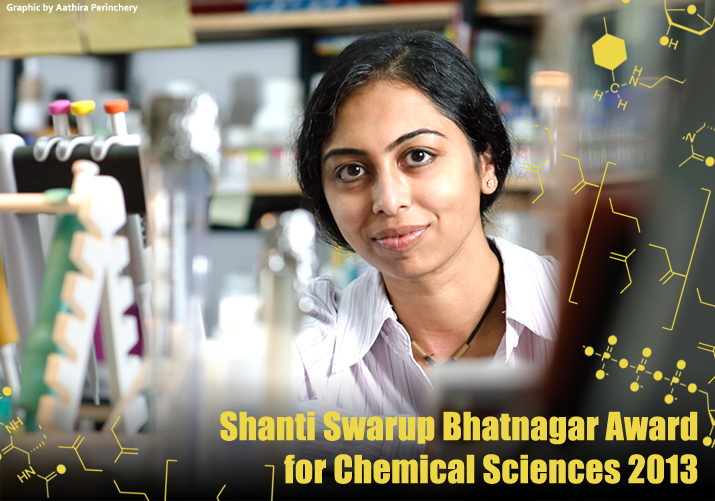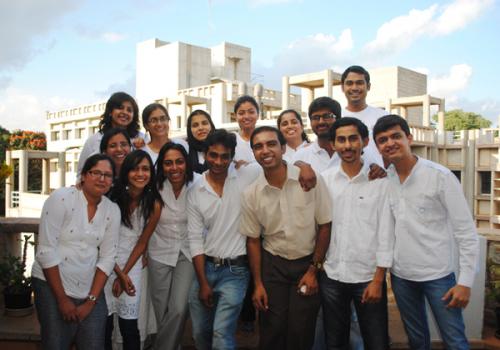Yamuna Krishnan wins Shanti Swarup Bhatnagar Award for Chemical Sciences
The Council for Scientific and Industrial Research (CSIR) has named NCBS Assistant Professor Yamuna Krishnan the recipient of the 2013 Shanti Swarup Bhatnagar Award for Chemical Sciences. This recognition is based on Krishnan's efforts to study the structure and dynamics of nucleic acids and exploit this understanding to make nanosensors that provide insights into the cell's chemical milieu. The Shanti Swarup Bhatnagar Prize is an annual award conferred by the CSIR in India. It was instituted in 1957 in honour of the late Dr. Shanti Swarup Bhatnagar, founder Director and principal architect of CSIR. Over 450 scientists and technologists from various disciplines of science have been awarded this prize for their outstanding contributions to research and development. Each award carries a citation, cash prize of INR 5,00,00, a plaque and an honorarium till retirement.
Krishnan's work in the Biochemistry, Biophysics and Bioinformatics Group at NCBS revolves around nucleic acids, large biological molecules that are found in every life form. Nucleic acids play central roles in the cell, where they function in encoding, transmitting and expressing genetic information. However, what is relatively less-appreciated about these macromolecules is their ability to form a range of unique structures, often very different from the familiar double helix, in response to an external cue.
Krishnan's group strives to understand these unusual forms and use them as a basis to design nucleic acid-based nanosensors for a specific external trigger. The novelty in this approach lies in taking these biological devices back into the cell and probing its chemical environment. By reporting on the whereabouts of various small molecules and ions in the cell, the technique can yield crucial insights into the roles they play in transducing information via proteins. It is this brilliant exploitation of the fundamental properties of nucleic acids that has helped her become a leading player in the field of DNA nanotechnology within a very short span of time.
A chemist by training, Krishnan was deeply interested in nucleic acids after her post-doctoral research at Cambridge. She came back to NCBS to do precisely that - study the chemistry of nucleic acids and the implications of this for the cell. She quickly learnt the language of biology, and then set out to speak it using the chemical alphabet. Her insights led to designing the first nucleic acid-based pH sensor capable of measuring perturbations in a cell's acidity in times of stress (Modi, S. et al., 2009, Surana, S. et al., 2011, Modi, S. et al., 2013). In parallel, her group built nanocages made of nucleic acids and investigated their potential applications as cargo carriers in living systems (Bhatia, D. et al., 2009, Bhatia, D., et al., 2011, Banerjee, A. et al., 2013). These studies were carried out in collaboration with Sandhya P. Koushika, a neuroscientist at TIFR, and Satyajit Mayor, Director of NCBS. Apart from building designer DNA scaffolds, Krishnan is also excited by the role of RNA structure in the cell (Chakraborty, S., et al., 2012).
Krishnan's enthusiasm and excitement in the lab is quite infectious. It is impossible to be around her and not be in awe of nucleic acids, something that will, one day, be the coup d'état in modern cellular biology, in her opinion. This is unequivocally accepted by all her students. Souvik, her first PhD student, recalls his initial scepticism of the potential applications of DNA architectures in living cells. However, Yamuna quickly won him over by sheer perseverance and cajoled him into doing crucial experiments, some of which were the basis of the Nature Nanotechnology paper which was the first demonstration of functionality of DNA nanomachines in cells (Modi, S. et al., 2009).
Krishnan believes in science being a collective effort and spends hours discussing ideas and experiments. Her insistence on excellence and acuity morphs even the most diffident students into go-getters, something that she jokingly refers to as creating more dragons like herself. Bhavya, a young PhD student in her lab, notes that it was only under Krishnan's guidance that she found a reservoir of curiosity within herself. "Yamuna has been a real teacher and mentor; not only has she pushed me to realize my best, but she inspires me to be better than I am capable of."
Sandhya P. Koushika, whose collaborations with Krishnan span five years, talks about how her work is remarkable in many aspects. "It has all the hallmarks one expects from very good scientists - creativity, rigour, a commitment to take the next big step and of course the joy of discovery. As her collaborator, I have enjoyed every aspect of our scientific interaction for her open-minded exploration of new ideas, fearless embrace of new approaches and dedication to bring ideas to their logical conclusion no matter how difficult the path."
Krishnan is quick to point out that the Bhatnagar Award is a recognition of what her whole group has achieved as a team - youngsters and seniors alike. In between discussions with students, congratulatory phone calls and an array of scientific talks, she sits quietly in her office, pondering the next hot destination for nucleic acid research.
(Story edited by Aathira Perinchery and Geoff Hyde)


Comments
Post new comment